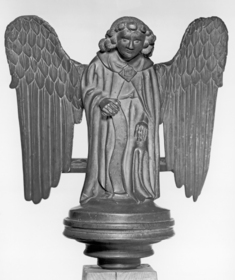Statuette of the Evangelist Symbol of Luke from a Lectern
(Renaissance Europe )
In 1852, an art historian visited the cathedral at Messina, Sicily and saw a "curious lectern worked in brass, and now used for the reading of the Gospels...The upper portion is made to revolve, so that a copy of each evangelist's writing being laid upon his proper emblem, the priest, standing on a step at the side, has only to turn the desk round until he has opposite to him the requisite gospel..."
The structure he saw was destroyed in the earthquake of 1908, which left the cathedral a ruin. However, the four book rests with the symbols of the Four Evangelists were preserved. Most Medieval lecterns included a single bookrest with an eagle that stood for Christ, while those for choirs often possessed two or three bookrests. This example thus might have originally belonged to a choir. Alternatively, it might have served as a book stand to hold the gospel books when they were not in use.
The four winged creatures described by Saint John in the Book of Revelation- a man, a lion, a bull, and an eagle- were later interpreted as representing Matthew, Mark, Luke, and John.
Many such brass objects for church use were produced in the eastern part of present-day Belgium for export to the rest of Europe.
Provenance
Provenance (from the French provenir, 'to come from/forth') is the chronology of the ownership, custody, or location of a historical object. Learn more about provenance at the Walters.
In the Cathedral of Messina, Italy, destroyed by earthquake in 1908; Raoul Heilbronner, Paris; Henry Walters, Baltimore, 1910, by purchase, Walters Art Museum, 1931, by bequest.
Exhibitions
| 1962 | The International Style: The Arts in Europe Around 1400. The Walters Art Gallery, Baltimore. |
Geographies
Belgium, Brabant
(Place of Origin)
Italy, Messina (Place of Discovery)
Measurements
H: 22 7/16 x W: 14 x D: 14 3/16 in. (57 x 35.5 x 36 cm)
Credit Line
Acquired by Henry Walters, 1910
Location in Museum
Centre Street: Third Floor: 15th-Century Art of Northern Europe
Accession Number
In libraries, galleries, museums, and archives, an accession number is a unique identifier assigned to each object in the collection.
In libraries, galleries, museums, and archives, an accession number is a unique identifier assigned to each object in the collection.
53.72



